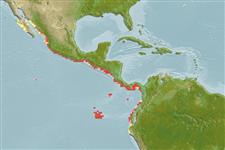Common names from other countries
Environment: milieu / climate zone / depth range / distribution range
Ecologia
; intervalo de profundidade 0 - 40 m (Ref. 4). Tropical, preferred 27°C (Ref. 107945); 28°N - 6°S, 115°W - 77°W (Ref. 112659)
Eastern Pacific: From Baja California Sur to the west coast of Peru and the Galapagos Islands.
Length at first maturity / Tamanho / Peso / Idade
Maturity: Lm ?, range 4 - ? cm Max length : 32.0 cm TL macho/indeterminado; (Ref. 4); 30 cm TL (female)
It has lengths of 32 cm (male) and 30 cm (female), maximum total body length; 1 to 13 cm (male) and 1 to 12 cm (female), carapace length (Ref. 4). Maximum depth from Ref. 112672. Occurs at depths from 0 to 18 m and it inhabits shallow coastal waters among rocks and in cracks and crevices. The animals are nocturnal (Ref. 4). Feeds mainly on mollusks, crustaceans and organic matter (Ref. 112086).
Life cycle and mating behavior
Maturidade | Reprodução | Desova | Ovos | Fecundidade | Larvas
Members of the order Decapoda are mostly gonochoric. Mating behavior: Precopulatory courtship ritual is common (through olfactory and tactile cues); usually indirect sperm transfer.
Holthuis, L.B. 1991. (Ref. 4)
Categoria na Lista Vermelha da IUCN (Ref. 130435)
Categoria CITES (Ref. 108899)
Not Evaluated
Not Evaluated
Utilização humana
Pescarias: espécies comerciais
FAO - pescarias: landings | FIRMS (Stock assessments) | FishSource | Sea Around Us
Ferramentas
Fontes da internet
Estimates based on models
Preferred temperature
(Ref.
115969): 22.7 - 29.1, mean 27 (based on 170 cells).
Resiliência
Elevada, tempo mínimo de duplicação da população menor que 15 meses (K=0.38-0.45).
Vulnerabilidade
Low vulnerability (22 of 100).
